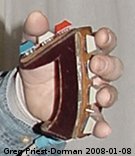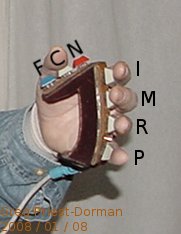Table of Contents
First Lesson : Basics
There's No Place Like Home
The keyboard described in these lessons is a 7 button1) chorder with one button assigned to each finger and three used by the thumb. This is not the only way to build a spiffchorder, but it is the design assumed in the lessons and charts in this section of this site. The Home Position for this arrangement of the chorder is the hand placement where each finger is resting (without pressing) on the button assigned to it and the thumb is on the middle button of the three buttons it uses. From this position combinations of the four finger buttons and the center thumb button will be used to produce the entire alphabet (and a little bit more).
By any other Name
To talk about the buttons on the chorder we need names for them. To give you graphical representations of the chords we need a chart. In this lession you will be introduced to the the naming and graphical conventions used on this site as well as a few of the basic concepts of chording.
Button Names
Since each button will be used in to produce of a number of different letters and symbols we can not name them the same way keys are named on a conventional keyboard.
The fingers each have one button to press, so we name the button for the finger that presses it. This gives us Index,Middle,Ring and Pinky. The thumb has three buttons and one or two can be pressed at a time. We name them for their location and relationship to the fingers, the middle thumb button is called Center, the one closest to the fingers is called Near and the outter most one is called Far. This gives us 7 unique identifyers for the buttons on the chorder:
| |||||||||||||||||||||||||||||||
The Power of One
With your hand in the home position the following characters are each typed by pressing one button:
Space i r y w2)
The entire alphabet, most common punctuation and all curser movements have single chord presses assigned to them. Often you will be pressing more than one button, but you press them together. One press of the buttons is a chord. You can press one, two, three, four, five or six3) buttons at the same time, as soon as you release any one of the buttons that chord is over.
Try pressing and releasing all five buttons in the home position at once. This chord gives you the letter o. If you chord the four fingers together you will get the letter t.
If we chart out the chords pressed above for a Left handed chorder it would look like this:
| Left Hand Chorder | |||||||||||
| fingers | thumb | ||||||||||
| P R M I | NCF | ||||||||||
| □□□□ | C | space | |||||||||
| □□□■ | i | ||||||||||
| □□■□ | r | ||||||||||
| □■□□ | y | ||||||||||
| ■□□□ | w | ||||||||||
| ■■■■ | C | o | |||||||||
| ■■■■ | t | ||||||||||
This is the basic way we chart the chords. The above chart shows the five chords each comprising of a single button press, the chord comprising all five home buttons pressed and the chord for all four fingers pressed.
You now have seven chords and can type a few words if you like.
For some things you press twice
To expand on the number of combinations available and make it easier to memorize, there are a few prefix chords. These are chords of one or more buttons that you press before pressing the chord in the chart to get a different (but usually related) result. Prefixes will be shown accross the top of the chart.
If you press Far (outer thumb button) followed by each of the seven chords you have learned, you will get these charactors:
Space I R Y W O T
As you can see, Far is like the shift key on a conventional keyboard and ShiftSpace is still a space. To put these on our chart, we add a column with what happens if we press Far before we press each of the single button chords
4)
| Left Hand Chorder | prefix | ||||||||||
| fingers | thumb | none | shift | ||||||||
| P R M I | NCF | F | |||||||||
| □□□□ | C | space | |||||||||
| □□□■ | i | I | |||||||||
| □□■□ | r | R | |||||||||
| □■□□ | y | Y | |||||||||
| ■□□□ | w | W | |||||||||
| ■■■■ | C | o | O | ||||||||
| ■■■■ | t | T | |||||||||
| ■■■■ | F | Caps Lck | |||||||||
Caps Lck works just like it does on a conventional keyboard. Press it once to lock it, again to unlock it.
Last but not least
There is only one button left. If you press Near (inner thumb button) before each of the home position chords that you now know you will get these:
1 2 3 4 5 0 0005)
If you press Near twice you get a Space6)
Near by itself acts as a prefix key as well, but rather than change the letter from lower case to upper case, it changes it from a letter to a number or symbol.
Adding a row for Near our chart now looks like this:
| Left Hand Chorder | Prefix Chord | ||||||||
|---|---|---|---|---|---|---|---|---|---|
| fingers | thumb | none | Shift | Num | |||||
| P R M I | NCF | F | N | ||||||
| □□□□ | C | space | 1 | ||||||
| □□□■ | i | I | 2 | ||||||
| □□■□ | r | R | 3 | ||||||
| □■□□ | y | Y | 4 | ||||||
| ■□□□ | w | W | 5 | ||||||
| ■■■■ | C | o | O | 0 | |||||
| ■■■■ | t | T | 000 | ||||||
| ■■■■ | F | Caps Lck | |||||||
| □□□□ | N | Number Prefix | space | ||||||
| ■■■■ | N | Number Prefix lock7) | |||||||
Double Up
Our chart is almost complete, if you now try pressing Far then Near followed by pressing the chords, you will get these keys:
! @ # $ % ) O00 Space
You may recognize these keys as shift with the numbers O through 5, that is what we would expect when we press shift and the number prefix, but
pressing 3 times to get one key is annoying so, you have a choice, you can press Far then Near, or, you can press a chord made up of 2 buttons both pressed with the thumb at the same time. Try pressing Center (the middle thumb button) at the same time as Near. This is the same as pressing the Far and then Near seporatly. So, the above keys can now be generated with a single prefix chord rather than two. Again, the chord for shift and number prefix together is the 2 button chord Center+Near.
Let's add that to the chart:
| Left Hand Chorder | Prefix Chord | ||||||||
|---|---|---|---|---|---|---|---|---|---|
| fingers | thumb | Shift | Num | Both | |||||
| P R M I | NCF | F | N | CN | |||||
| □□□□ | C | space | space | 1 | ! | ||||
| □□□■ | i | I | 2 | @ | |||||
| □□■□ | r | R | 3 | # | |||||
| □■□□ | y | Y | 4 | $ | |||||
| ■□□□ | w | W | 5 | % | |||||
| ■■■■ | C | o | O | 0 | ) | ||||
| ■■■■ | t | T | 000 | ||||||
| □□□□ | N | Number Prefix | space | ||||||
What does it all mean?
One advantage to the chorder is that there are so many possible combinations that we can afford some redundancy if it makes typing easier. One way to do that is with mnumonics. You will see later that once you learn the alphabet chords there are ways to to type % and . (period) based on the letter “p”, ways to type ' (apostrapy), + (addition) based on the letter “a” and many more. For now you have been introduced to the 3 common modifiers; F - shift, N - number-prefix and CN for both together as well as how to read the charts that we use display the chords. The only peice left for this lession is to have a look at the final chart. It looks like the last one with the additon of chord pictures for Right handded chorders, its the same information, just flipped around:
| Left Hand Chorder | Prefix Chord | Right Hand Chorder | |||||||||
|---|---|---|---|---|---|---|---|---|---|---|---|
| fingers | thumb | Shift | Num | Both | thumb | fingers | |||||
| P R M I | NCF | F | N | CN | FCN | I M R P | |||||
| □□□□ | C | space | space | 1 | ! | C | □□□□ | ||||
| □□□■ | i | I | 2 | @ | ■□□□ | ||||||
| □□■□ | r | R | 3 | # | □■□□ | ||||||
| □■□□ | y | Y | 4 | $ | □□■□ | ||||||
| ■□□□ | w | W | 5 | % | □□□■ | ||||||
| ■■■■ | C | o | O | 0 | ) | C | ■■■■ | ||||
| ■■■■ | t | T | 000 | ■■■■ | |||||||
| □□□□ | N | Number Prefix | space | N | □□□□ | ||||||
You can now read the charts used here to explain the chords, not all charts use the same columns but all work the same way so, read the charts and learn some chords.
Far before any letter you want capitolzed if fine for the beginig of a sentence, but if you want to type a string of capitol letters Caps Lck would be much more convinient.Near becomes helpful if you are in number-prefix with Number prefix lock


